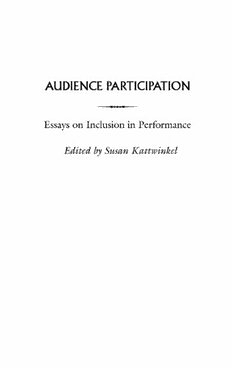
Audience Participation: Essays on Inclusion in Performance PDF
Preview Audience Participation: Essays on Inclusion in Performance
AUDIENCE PARTICIPATION: Essays on Inclusion in Performance Susan Kattwinkel Editor PRAEGER AUDIENCE PARTICIPATION RecentTitlesin ContributionsinDramaandTheatreStudies GowerChampion:DanceandAmericanMusicalTheatre DavidPayne-Carter DramatistsandtheBomb:AmericanandBritishPlaywrightsConfronttheNuclear Age CharlesA.Carpenter Thatcher’sTheatre:BritishTheatreandDramaintheEighties D.KeithPeacock ReinventingDrama:Acting,Iconicity,Performance BruceG.Shapiro DocumentaryTheatreintheUnitedStates:AnHistoricalSurveyandAnalysisofIts Content,Form,andStagecraft GaryFisherDawson ActorasAnti-Character:Dionysus,theDevil,andtheBoyRosalind LesleyWadeSoule Shakespeare’sUnorthodoxBiography:NewEvidenceofanAuthorshipProblem DianaPrice TheGlamourofGrammar:OralityandPoliticsandtheEmergenceofSeanO’Casey ColbertKearney FathersandDaughtersinShakespeareandShaw LagrettaTallentLenker TheBestActorsintheWorld:ShakespeareandHisActingCompany DavidGrote SyngeandIrishNationalism:ThePrecursortoRevolution NelsonO’CeallaighRitschel TechnologyinAmericanDrama,1920–1950:SoulandSocietyintheAgeofthe Machine DennisG.Jerz AUDIENC(cid:1)E PARTICIPATION Essays on Inclusion in Performance Edited by Susan Kattwinkel ContributionsinDramaandTheatreStudies,Number101 LibraryofCongressCataloging-in-PublicationData Audienceparticipation:essaysoninclusioninperformance/editedbySusanKattwinkel. p.cm.—(Contributionsindramaandtheatrestudies,ISSN0163–3821;no.101) Includesbibliographicalreferencesandindex. ISBN0–313–31671–6(alk.paper) 1.Performingarts—Audiences. I.Kattwinkel,Susan. II.Series. PN1590.A9A89 2003 791—dc21 2002029893 BritishLibraryCataloguinginPublicationDataisavailable. Copyright(cid:1)2003bySusanKattwinkel Allrightsreserved.Noportionofthisbookmaybe reproduced,byanyprocessortechnique,withoutthe expresswrittenconsentofthepublisher. LibraryofCongressCatalogCardNumber:2002029893 ISBN:0–313–31671–6 ISSN:0163–3821 Firstpublishedin2003 PraegerPublishers,88PostRoadWest,Westport,CT06881 AnimprintofGreenwoodPublishingGroup,Inc. www.praeger.com PrintedintheUnitedStatesofAmerica Thepaperusedinthisbookcomplieswiththe PermanentPaperStandardissuedbytheNational InformationStandardsOrganization(Z39.48–1984). 10 9 8 7 6 5 4 3 2 1 CopyrightAcknowledgments Theauthorandthepublishergratefullyacknowledgepermissionforuseofthefollowing material: ExcerptsfromaninterviewSusanKattwinkelheldwithFelixRuckert.Usedwithpermission. ExcerptsfromaninterviewPatrickTuiteheldwithEamonnDeane.Usedwithpermission. ExcerptsfromRobertAlexander,LettertoanActress,LivingStageArchives.Usedwith permission. ExcerptsfromMarkWeinberg,“Community-BasedTheatre:AParticipatoryModelforSocial Transformation,”TheatreSymposium:APublicationoftheSoutheasternTheatreConference, Vol.8,pp.22–33.PublishedbytheSoutheasternTheatreConferenceandTheUniversityof AlabamaPress,2000(cid:1)2000byTheUniversityofAlabamaPress. Everyreasonableefforthasbeenmadetotracetheownersofcopyrightmaterialsinthisbook, butinsomeinstancesthishasprovenimpossible.Theauthorandpublisherwillbegladto receiveinformationleadingtomorecompleteacknowledgmentsinsubsequentprintingsofthe bookandinthemeantimeextendtheirapologiesforanyomissions. CONTENTS Acknowledgments vii Introduction ix 1 Ethics of the Witness: The ParticipatoryDances of Cie Felix Ruckert 1 Joshua Abrams 2 Reaction Tactics: Redefining Postmodern Spectator Response and Expectations 15 Katherine Adamenko 3 Still Signaling through the Flames: The Living Theatre’s Use of Audience Participationin the 1990s 23 David Callaghan 4 It Matters for whom You Dance: Audience Participation in Rasa Theory 37 Uttara Asha Coorlawala 5 Audience Participationin the Eighteenth-Century London Theatre 55 Judith W. Fisher 6 The Challenge of Participation:Audiences at Living Stage Theatre Company 71 Susan C. Haedicke vi CONTENTS 7 Manipulation of the Mind: Fiction in the Performances of Penn and Teller 89 Susan Kattwinkel 8 Looking at Looking (at Looking): Experiments in the Interrogation of Spectating 101 Joanne Klein 9 The Audience in Cyberspace: Audience-Performer Interactivity in Online Performances 115 Nina LeNoir 10 Once upon a Time: The Story of the Pantomime Audience 133 Dawn Lewcock 11 Audience at Risk: Space and Spectatorsat Feminist Performance 149 Judith Sebesta 12 “Walking in the Steps of Your Forefathers”: Locating the Actor and the Audience in Derry’s Siege Pageant 167 Patrick Tuite 13 Community-BasedTheatre: A ParticipatoryModel for Social Transformation 185 Mark S. Weinberg 14 The (Oc)cult of Personality: Initiating the Audience into The EdwardianMysteries 199 J. Lawton Winslade Index 213 AbouttheAuthors 217 ACKNOWLEDGMENTS Many thanks, first of all, to the authors in this volume. They were, without exception, prompt in all replies, flexible with my editorial requests, and pa- tientwhileIjuggledthesedutieswithteachinganddirectingprojects.Thanks especially to Judith Sebesta, who stepped briefly into editorial shoes to help mewiththeIntroduction. The Theatre Department at the College of Charleston provided me with resources and time to work on this volume, and I am also grateful for the patienceofmyeditorsatGreenwoodPress. Finally, as always, much love to my parents, John and Phyllis Kattwinkel, andtomysister,LindaKattwinkel,fortheircontinuingloveandsupport. INTRODUCTION Weknowthataudiencesaffectperformancesthroughtheirreactions—laugh- ter, sighs, restlessness—and in most traditional Western theatre, those re- sponses are generally polite and unobtrusive. Audiences also have influence as new professional productions are tinkered with to some extent following “preview”performances.Andalthoughtheatreisrecognizedasbeingincom- pleteuntilanaudiencewitnessesitandcreatesitforthemselvesintellectually, spectatorsaregenerallyrelegatedto“receiver”status,havinglittleimpacton theprocessofperformanceexceptinstandard,structuredresponse.Thepas- siveaudience,ofcourse,isarelativelynewconditionoftheatricalexperience, but nevertheless has become so prevalent that it is the status quo for most theatre in the West. The passive audience really only came into being in the nineteenth century, as theatre began its division into artistic and entertain- ment forms. Practitioners and theorists such as Wagner, with his “mystic chasm,” and he and Henry Irving with their darkened auditoriums, took someofthemanysmallstepsinthenineteenthcenturythatpsychicallysepa- rated the audience from the performance and discouraged spectatorial acts of ownership or displeasure, or even vociferous approval.1 This expectation ofthesilentaudiencehasbecomesoacceptedthatina1991NewYorkTimes article on the bad manners of theatre patrons, the columnist Alex Witchel did not even mention the history behind his demand for politeness or ac- knowledge that truly good theatre often inspires in its spectators just the opposite of the motionless silence he desired.2 This polite, awed reception hascometobethenorm. Buthistoricallyandinagrowingvarietyoftheatricalformstoday,ithasbeen a very different matter. For the theatre and dance performances investigated
